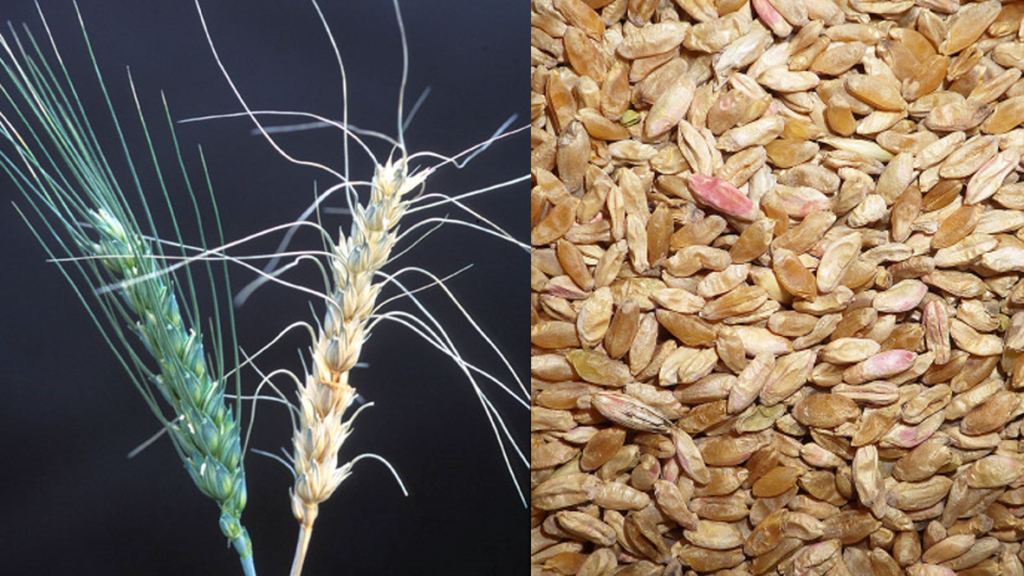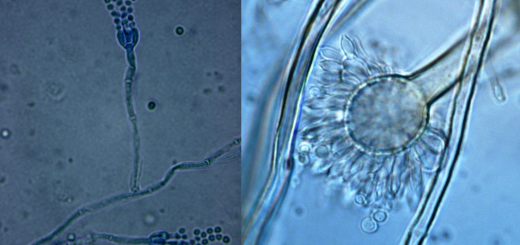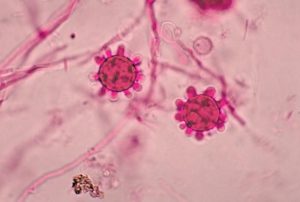#203: Deoxynivalenol

Fusarium species cause Fusarium head blight in cereal grains. The primary symptoms of this blight are scabby and prematurely bleached kernels. The left photo compares a healthy head of wheat to a blighted one. The right photo compares scabby kernels (paler to pinkish and wrinkly) to normal ones. Left photo by the USDA’s Agricultural Research Service. Right photo by Andrew Friskop, North Dakota State University CC BY-NC-SA 3.0 (cropped).
Deoxynivalenol (DON) is a toxin found in grains infected with the fungus Fusarium graminearum and other Fusarium species. It is often called “vomitoxin” because it primarily causes vomiting in humans and livestock. Its long-term effects are mild, but it is still a very important mycotoxin because it is the most common mycotoxin found in food.1,2
Sources
Deoxynivalenol is found produced by fungi in the genus Fusarium that infect grains. Globally, the most common of these fungi is F. graminearum, also known as Giberella zeae (the name of its sexual stage [note]).3 These fungi can infect any type of cereal grain – including wheat, corn (maize), rice, and triticale – although they are most problematic for wheat, barley, oats, and similar grasses.3,4 DON is tolerant of heat well above the boiling point of water, so humans are most often exposed to it through grain-based foods that have been cooked.4 However, DON is water-soluble, so foods boiled in water and then removed (such as pasta) have lower concentrations of DON.5 How you are exposed to DON is highly dependent upon regional diet, although it is usually through staple foods. In Europe, the top four sources of human exposure to DON are (from highest exposure to lowest): breads, raw pasta, bakery items, and mill products.4
In grains, Fusarium species cause a disease called Fusarium head blight or scab. In the spring, spores from the fungus land on and infect flowers. Successful infection requires warm temperatures, high humidity, and rain. Early infections kill the flowers and prevent kernel formation. Later infections allow kernels to develop, but result in “tombstones”: kernels are bleached, shrunken, and shriveled. The infection can spread up and down the head, sometimes bleaching the entire head. Very late infections may not impact kernel appearance at all. Those kernels may be able to germinate in the following year, but the fungus will stunt the plant’s growth.6
Fusarium species can also infect grains during storage. The fungus stops growing when the humidity of a kernel is less than 22%, so preventing more infections in stored grain is a simple matter of keeping it all sufficiently dry.2
F. graminearum and its relatives are plant pathogens and produce DON as a normal part of their infective process. Any infected tissues can contain DON, but humans and animals are usually exposed through infected kernels.3 Both bleached and symptomless kernels can contain DON, and the levels of the toxin vary widely. It is therefore impossible to predict the DON content of any single kernel by its appearance.2
Structure and Mechanism
Deoxynivalenol belongs to a class of toxins called trichothecenes. Chemists group trichothecenes into four major types, with DON belonging to type B.3 These are small but bulky molecules built on a backbone of two six-atom rings, one five-atom ring, and one three-atom ring. This is a rather unusual configuration and the whole molecule ends up in a kind of warped Y shape.3,7 Appropriately for its shape, it has a confusingly long formal name: 12,13-epoxy-3,4,15-trihydroxy-trichothec-9-en-8-one.8

Structure of deoxynivalenol. Photo by PubChem.
In plants, DON functions by blocking protein synthesis. Specifically, it interferes with the ribosome’s ability to read mRNA and assemble proteins. Without the ability to produce new proteins, the cell eventually stops functioning and dies. Unlike type A trichothecenes, DON blocks protein synthesis without triggering the plant’s defenses. This is beneficial to the fungus because it helps the fungus infect and kill plant cells with as little resistance as possible.3
In animal cells, DON also blocks protein synthesis and thereby damages cells.4 Additionally, the toxin interferes with the central nervous system.5,8 High levels of the toxin can increase serotonin signaling in the brain and cause vomiting. Over the long-term, deoxynivalenol can lower cytokine signaling in the pituitary gland, which causes a reduction in appetite.8
Fusarium fungi also produce a variety of DON derivatives, although these appear to be less abundant and less toxic than DON and they are generally ignored. However, some of these – in particular DON-3-glucoside – may be transformed into DON by animal or human metabolism, although scientists do not know if that actually happens.4,8,9
Symptoms
The amount of DON required to cause symptoms in animals varies from one species to the next. Humans and pigs are among the most susceptible animals, while cows and chickens are among the least.9 For humans and pigs, a dose of about 50µg per kilogram of body weight is the minimum amount to cause noticeable short-term symptoms.8,9 These symptoms generally include vomiting, nausea, and (sometimes bloody) diarrhea4,8,9 Ridiculously high doses of DON can cause death, but it is nearly impossible to be exposed to that much DON through normal food sources. In mice, the fatal dose is 46-78mg per kilogram of body weight.5
Long-term symptoms are much subtler. They include reduced growth (measured by weight gain), poor appetite, reduced ability to absorb nutrition from food, and weakening of the immune system.8,9 In experiments with bacteria as well as in data from real-world human populations, DON is not linked to cancer.4,5,8 It does seem to cause chromosomes to develop breaks, but that is not linked to any noticeable genetic problems.5,8
Impacts
The biggest impacts of deoxynivalenol and Fusarium spp. are felt by farmers. Fusarium head blight is one of the most significant causes of crop loss around the world. In the United States, the blight caused over three billion dollars in damages to wheat and barley farms between 1990 and 2010.6 Since the disease affects staple foods, it has a great potential to impact regional food security.
Deoxynivalenol itself is usually not very problematic because its symptoms are generally mild and because most countries have limits on DON concentration in food. Some of the worst outbreaks of DOM poisoning occurred in the early 20th century. In 1928, a large number of pigs in the United States became sick after being fed DON-infected grain. In the 1930’s, people in Central Asia and Japan became sick from DON, with most displaying symptoms of food poisoning. Some people in Central Asia died as a result of skin and organ lesions during the outbreak.10
Solutions
To avoid future outbreaks and reduce long-term health impacts, the World Health Organization recommends that human consumption of DON be no more than 1µg per kilogram of body weight per day.4,8 In the United States, allowed levels of DON are considerably higher than this; the U.S. Food and Drug Administration allows no more than 1ppm (roughly 25µg per kg body weight11) DON in food destined for human consumers.12 In a long-term study in mice, no long-term effects were seen for exposure rates at or below 100µg per kg body weight per day,8 so the U.S. regulations are sufficient to keep consumers safe.
There are some methods to reduce the amount of DON in seed lots where the level is too high, although these are not always effective. Mechanical methods that separate out the scabby kernels from the asymptomatic ones do help improve the shelf life of the grain, but will not necessarily reduce DON concentration.2 The most effective process is to wash or soak the grain in water or in a solution of baking soda.8
The best thing farmers can do to ensure low levels of DON in their products is to properly care for their crops. Plants are more susceptible to disease when stressed, so farmers can help prevent infection by ensuring the plants are properly fertilized, watered, cleared of weeds, and effectively rotated.8 Applying fungicides at the right time during the plant’s life cycle can also reduce rates of Fusarium infection. Proper timing depends on the crop species and ranges from early flowering (as in wheat) to after all the kernels have begun developing (as in barley). The most effective fungicides for combating Fusarium head blight are in the triazole family.2 Farmers can also take advantage of the resistant crop strains that have been developed.2,8
Researchers are also looking into using biological control agents to combat Fusarium. Most of the possible candidates are bacteria and fungi. The most promising species are Bacillus spp. and Cryptococcus flavescens.6,8
Do not use information in this post to self-diagnose or self-treat a medical complaint. Always consult a licensed medical doctor for proper diagnosis and treatment of a health issue.
See Further:
https://www.apsnet.org/edcenter/intropp/lessons/fungi/ascomycetes/Pages/Fusarium.aspx
http://apps.who.int/iris/bitstream/10665/44514/1/WHO_TRS_959_eng.pdf (pdf, dense, and includes a lot more than just deoxynivalenol)
Citations
- Kuldau, G. Mycotoxins: The Good, the Bad, and the Ugly. (2017).
- Friskop, A. & Ransom, J. Plant Disease Management: Deoxynivalenol (DON) in Small Grains. North Dakota State University (2017). Available at: https://www.ag.ndsu.edu/publications/crops/plant-disease-management-deoxynivalenol-don-in-small-grains-1. (Accessed: 16th November 2017)
- Masuda, D. et al. Phytotoxic effects of trichothecenes on the growth and morphology of Arabidopsis thaliana. J Exp Bot 58, 1617–1626 (2007).
- European Food Safety Authority. Deoxynivalenol in food and feed: occurrence and exposure. EFSA Journal 11, (2013).
- Sobrova, P. et al. Deoxynivalenol and its toxicity. Interdiscip Toxicol 3, 94–99 (2010).
- Schmale III, D. G. & Bergstrom, G. C. Fusarium head blight (FHB) or scab. The Plant Health Instructor (2010). doi:10.1094/PHI-I-2003-0612-01
- Pubchem. Compound Summary for CID 40024: DEOXYNIVALENOL. National Center for Biotechnology Information PubChem Compound Database Available at: https://pubchem.ncbi.nlm.nih.gov/compound/40024. (Accessed: 16th November 2017)
- Joint FAO/WHO Expert Committee on Food Additives. Evaluation of Certain Contaminants in Food: Seventy-second report of the Joint FAO/WHO Expert Committee on Food Additives. (World Health Organization, 2010).
- Pestka, J. J. Deoxynivalenol: Toxicity, mechanisms and animal health risks. Animal Feed Science and Technology 137, 283–298 (2007).
- Wegulo, S. N. Factors Influencing Deoxynivalenol Accumulation in Small Grain Cereals. Toxins (Basel) 4, 1157–1180 (2012).
- Joint FAO/WHO Expert Committee on Food Additives. Guidelines for the preparation of toxicological working papers for the Joint FAO/WHO Expert Committee on Food Additives. (2000).
- Division of Plant and Dairy Food Safety in the Center for Food Safety and Applied Nutrition & Office of Surveillance and Compliance in the Center for Veterinary Medicine. Guidance for Industry and FDA: Advisory Levels for Deoxynivalenol (DON) in Finished Wheat Products for Human Consumption and Grains and Grain By-Products used for Animal Feed. U.S. Food & Drug Administration (2010). Available at: https://www.fda.gov/Food/GuidanceRegulation/GuidanceDocumentsRegulatoryInformation/ChemicalContaminantsMetalsNaturalToxinsPesticides/ucm120184.htm. (Accessed: 16th November 2017)

![#069: Amanita muscaria, Part 1: The Type Mushroom [Archived]](https://www.fungusfactfriday.com/wp-content/themes/hueman/assets/front/img/thumb-medium-empty.png)






![#011: Characteristics of Kingdom Fungi [Archived]](https://www.fungusfactfriday.com/wp-content/themes/hueman/assets/front/img/thumb-small-empty.png)


1 Response
[…] Random Post […]